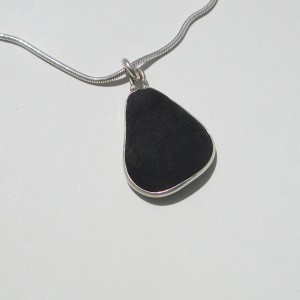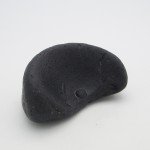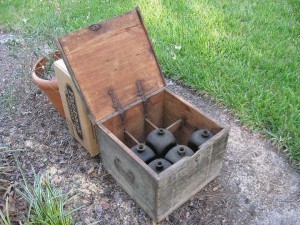Elusive Black Sea Glass

Elusive Black Sea Glass
If you pick up a black stone on a beach, you may be surprised to find that it is actually a piece of black glass. Black glass dates back to the late 1700’s and early 1800’s, when ships were the primary means of transporting merchandise. It was important that the glass containers be dark enough to minimize sun light exposure in order to protect its contents from spoilage and to be hard and heavy enough to prevent breakage. Iron oxide, which was added when producing the glass, created the dark color and the hardness of the glass. The many shipwrecks that occurred at this time now enable us to find large chunks of black sea glass.
 As many of you know, we spend the winter months in the Abaco Islands in the Northern Bahamas. Here we find the majority of the sea glass we use to create our jewelry. The Bahamas is one of the few places where you can find black sea glass. At one time ships traveling from New England would take the route around the Bahamas to avoid the strong current of the Gulf Stream. There were numerous shipwrecks on the reefs off the Abaco Islands in the time period prior to the building of the lighthouse in 1859, so the black sea glass is prevalent here. We found this large piece of sea glass in Hope Town. The Ballston Spa Bottle Museum dated the piece back to the late 1700’s. Historically, glass blowers were paid by piecemeal. The dot you see in the glass represents the mark a glass blower used to identify the pieces he made.
As many of you know, we spend the winter months in the Abaco Islands in the Northern Bahamas. Here we find the majority of the sea glass we use to create our jewelry. The Bahamas is one of the few places where you can find black sea glass. At one time ships traveling from New England would take the route around the Bahamas to avoid the strong current of the Gulf Stream. There were numerous shipwrecks on the reefs off the Abaco Islands in the time period prior to the building of the lighthouse in 1859, so the black sea glass is prevalent here. We found this large piece of sea glass in Hope Town. The Ballston Spa Bottle Museum dated the piece back to the late 1700’s. Historically, glass blowers were paid by piecemeal. The dot you see in the glass represents the mark a glass blower used to identify the pieces he made.
Case Gin produced square bottles for sea shipment to better utilize the space in shipping crates. As boaters, Bruce and I think these producers must have been geniuses. Square wine bottles would certainly help alleviate our storage problems on board.

Black sea glass is often overlooked when beachcombing. The shard may look like just another stone. In order to identify any piece of sea glass, you need to hold it up to the sunlight to validate its transparency. True sea glass should have a green or brownish tinge. One of these colors should be seen in authentic black sea glass jewelry when held up to the light. However, when you hold the sea glass against your skin, it absorbs the light and is perfectly black. If you use these hints the next time you are searching for sea glass, you may find that some of those black stones you observed are actually very old pieces of black sea glass.

